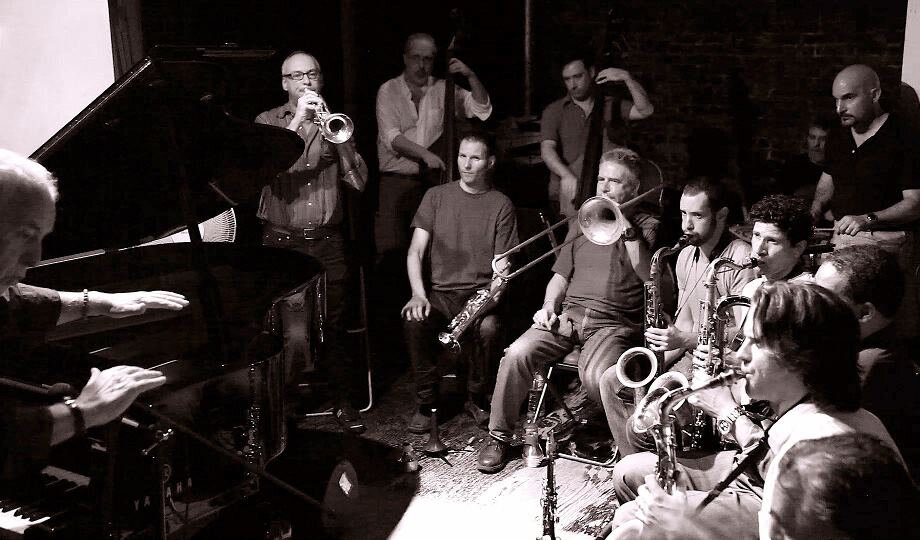Karl Berger's Improvisers Orchestra
 "Free jazz orchestras tend to be even more spontaneous—improvising music that's even less pre-composed—than their small-group counterparts," writes Will Friedwald in The Wall Street Journal. "Yet the compositions of Karl Berger have a clear-cut destination, with a beginning, a middle, and an ending. Mr. Berger (best known as a vibraphonist, but here playing piano) focuses on the relationship between noise and music. He lingers on those transitional moments wherein a swirling morass of chaotic sounds gradually coalesces into a genuine melody."Karl Berger is a man of many hats: composer, arranger, conductor, vibraphonist, pianist. He has collaborated with a range of artists including Don Cherry, Lee Konitz, John McLaughlin, Gunther Schuller, and many more, and won the Downbeat Critics' Poll for six consecutive years in the jazz vibraphone category. Karl's arrangements have also been featured on recordings by Jeff Buckley, The Cardigans, Bootsy Collins, and Angelique Kidjo, among others.Karl developed his approach at the Creative Music Studio (CMS), which he co-founded with Ornette Coleman and Ingrid Sertso in Woodstock, NY. An organization dedicated to the study of new and creative directions in music, CMS was instrumental in bringing together leading innovators representing traditions from around the world. The initial advisory council included luminaries John Cage, Gil Evans, Buckminster Fuller, Willem de Kooning, George Russell, and Gunther Schuller.The Jazz Gallery will present Karl's Improvisers Orchestra every two weeks starting this Tuesday, March 20th. Following Karl's critically acclaimed workshop series last year at The Stone, the Improvisers Orchestra will "turn improvisational ideas developed in the 7:30 pm workshop/rehearsal into a fully formed 9:00 pm performance." All net proceeds will benefit the CMS Archive Project.Karl speaks:
"Free jazz orchestras tend to be even more spontaneous—improvising music that's even less pre-composed—than their small-group counterparts," writes Will Friedwald in The Wall Street Journal. "Yet the compositions of Karl Berger have a clear-cut destination, with a beginning, a middle, and an ending. Mr. Berger (best known as a vibraphonist, but here playing piano) focuses on the relationship between noise and music. He lingers on those transitional moments wherein a swirling morass of chaotic sounds gradually coalesces into a genuine melody."Karl Berger is a man of many hats: composer, arranger, conductor, vibraphonist, pianist. He has collaborated with a range of artists including Don Cherry, Lee Konitz, John McLaughlin, Gunther Schuller, and many more, and won the Downbeat Critics' Poll for six consecutive years in the jazz vibraphone category. Karl's arrangements have also been featured on recordings by Jeff Buckley, The Cardigans, Bootsy Collins, and Angelique Kidjo, among others.Karl developed his approach at the Creative Music Studio (CMS), which he co-founded with Ornette Coleman and Ingrid Sertso in Woodstock, NY. An organization dedicated to the study of new and creative directions in music, CMS was instrumental in bringing together leading innovators representing traditions from around the world. The initial advisory council included luminaries John Cage, Gil Evans, Buckminster Fuller, Willem de Kooning, George Russell, and Gunther Schuller.The Jazz Gallery will present Karl's Improvisers Orchestra every two weeks starting this Tuesday, March 20th. Following Karl's critically acclaimed workshop series last year at The Stone, the Improvisers Orchestra will "turn improvisational ideas developed in the 7:30 pm workshop/rehearsal into a fully formed 9:00 pm performance." All net proceeds will benefit the CMS Archive Project.Karl speaks:
While we study our instruments and discipline our musical minds, our materials begin to surface. Finally, there can be the liberating experience that the material is not the point at all: we train ourselves to become instruments when the music can flow through freely, like electricity through a transmitter. We don’t know where it is going. We don’t even know what it is doing. We are only as ready as possible, keeping the tools sharp, keeping fine tuning, essentially empty so we can vibrate.
The New York Times has listed Karl's run as a Critics' Pick.Watch footage taken from Karl's run at The Stone last year: "Transitions" and "Nameless Child"
